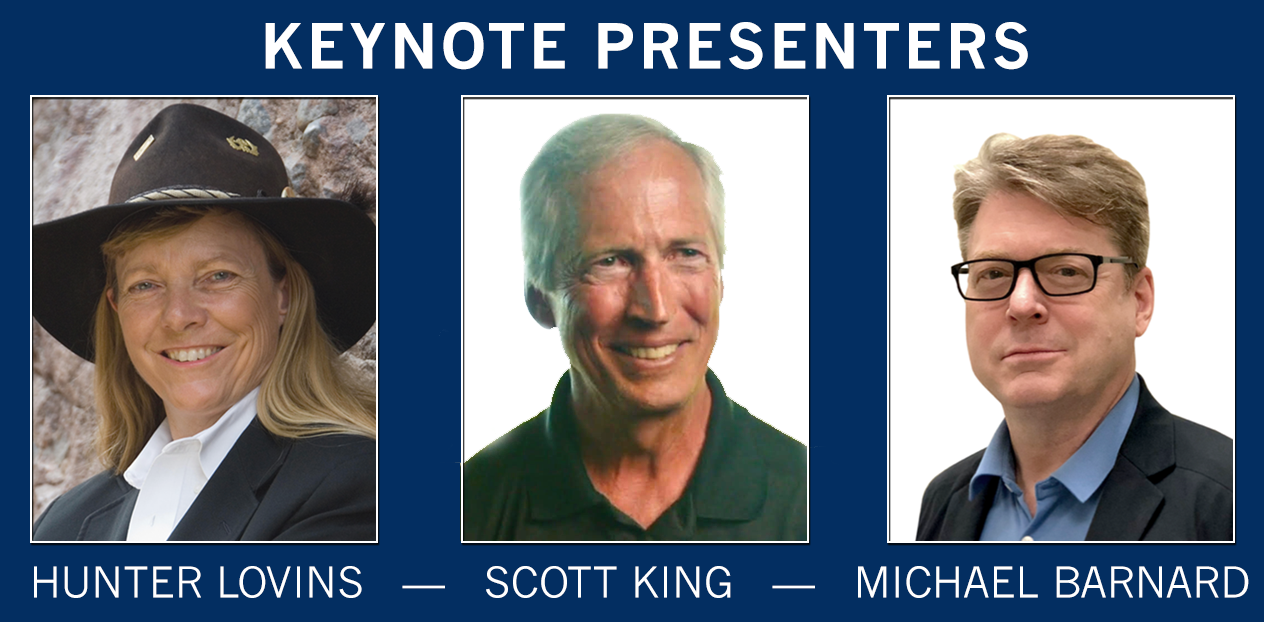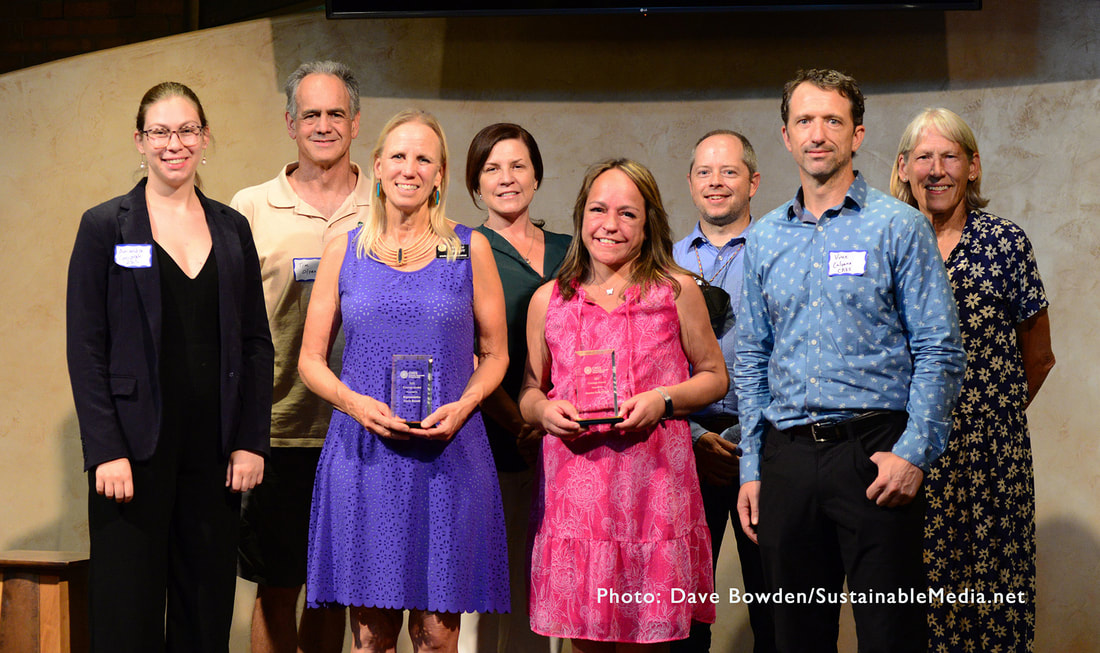Recordings
Watch all Presentation Recordings
View the presentation recordings from the 2022 CRES Conference via the button below. You can also watch all recordings in order on our YouTube channel.
ABOUT
Why this conference? Why Now?
It is hard to overstate how much has changed on the energy front in the past decade. This conference will show how key elements in this evolving energy landscape fit together and why we stand a real chance to solve climate when we solve energy.
Our sessions focus on selected pillars of the energy transition, starting with the requirements for a modernized power grid that can handle intermittent and distributed renewables, and the big role for storage in making the grid reliable.
We’ll visit promising new solar contenders, namely floating solar and agrivoltaics, both of which allow solar to coexist while doubling income streams without monopolizing valuable real estate. We'll also take a look at community solar.
Building electrification deserves a conference of its own, so we decided to at least give you a ‘teaser’: The whole enchilada in half an hour!
Microgrids produce, store and manage power on site, and were chiefly used as diesel fueled emergency power. But as renewable microgrids become cheaper and more reliable than power from transmission lines ’grid defection’ might shake up the system.
Our final session examines Colorado’s leadership in the energy transition with presenters who helped to make it happen.
We are bracketing the day with two keynotes: Hunter Lovins and Scott King argue “Why Students and Entrepreneurs will solve climate”, and at the end Michael Barnard from Canada gives a blunt comparison of energy solutions that are largely marketing hype versus true winners whose technological and cost advantages will push out fossil fuel at the scale and speed we need to curb the climate crisis.
Our sessions focus on selected pillars of the energy transition, starting with the requirements for a modernized power grid that can handle intermittent and distributed renewables, and the big role for storage in making the grid reliable.
We’ll visit promising new solar contenders, namely floating solar and agrivoltaics, both of which allow solar to coexist while doubling income streams without monopolizing valuable real estate. We'll also take a look at community solar.
Building electrification deserves a conference of its own, so we decided to at least give you a ‘teaser’: The whole enchilada in half an hour!
Microgrids produce, store and manage power on site, and were chiefly used as diesel fueled emergency power. But as renewable microgrids become cheaper and more reliable than power from transmission lines ’grid defection’ might shake up the system.
Our final session examines Colorado’s leadership in the energy transition with presenters who helped to make it happen.
We are bracketing the day with two keynotes: Hunter Lovins and Scott King argue “Why Students and Entrepreneurs will solve climate”, and at the end Michael Barnard from Canada gives a blunt comparison of energy solutions that are largely marketing hype versus true winners whose technological and cost advantages will push out fossil fuel at the scale and speed we need to curb the climate crisis.
SESSION INFO
List of Conference Presenters by session in sequence
At a glance...
S-0 Opening remarks
S-1 Keynote Hunter Lovins & Scott King: Why Students & Entrepreneurs Will Solve Climate
Hunter Lovins, Natural Capitalism Solutions
Scott King, Mission Zero
S-2 The New Grid: Balancing Transmission, Storage, & Local Energy
Kyri Baker, CU Boulder
Nate Blair, National Renewable Energy Laboratory (NREL)
David Hurlbut, National Renewable Energy Laboratory (NREL)
Ron Sinton, Sinton Instruments
S-3 Solar Beyond Rooftops: Whatever Floats Your Load
Sika Gadzanku, National Renewable Energy Laboratory (NREL)
Austin Kinzer, National Renewable Energy Laboratory (NREL)
Allison Jackson, Jack’s Solar Garden
S-4 Building Electrification: The Whole Enchilada In Half an Hour
Christine Brinker, Southwest Energy Efficiency Project (SWEEP)
Josh Lake, Elephant Energy
S-5 Microgrids: From Micro to Mega?
Peter Lilienthal, Homer Energy, UL
Larry Sherwood, Interstate Renewable Energy Council (IREC)
S-6 Colorado’s Leadership In The Energy Transition
Alyssa Russell, Denver's Office of Climate Action, Sustainability, and Resiliency (CASR)
Vince Calvano, Colorado Renewable Energy Society
Will Toor, CEO, Colorado’s Energy Office
S-7 Keynote Michael Barnard: What’s Wrong With “All Of The Above”?
Michael Barnard, The Future Is Electric
S-8 Closing remarks
S-1 Keynote Hunter Lovins & Scott King: Why Students & Entrepreneurs Will Solve Climate
Hunter Lovins, Natural Capitalism Solutions
Scott King, Mission Zero
S-2 The New Grid: Balancing Transmission, Storage, & Local Energy
Kyri Baker, CU Boulder
Nate Blair, National Renewable Energy Laboratory (NREL)
David Hurlbut, National Renewable Energy Laboratory (NREL)
Ron Sinton, Sinton Instruments
S-3 Solar Beyond Rooftops: Whatever Floats Your Load
Sika Gadzanku, National Renewable Energy Laboratory (NREL)
Austin Kinzer, National Renewable Energy Laboratory (NREL)
Allison Jackson, Jack’s Solar Garden
S-4 Building Electrification: The Whole Enchilada In Half an Hour
Christine Brinker, Southwest Energy Efficiency Project (SWEEP)
Josh Lake, Elephant Energy
S-5 Microgrids: From Micro to Mega?
Peter Lilienthal, Homer Energy, UL
Larry Sherwood, Interstate Renewable Energy Council (IREC)
S-6 Colorado’s Leadership In The Energy Transition
Alyssa Russell, Denver's Office of Climate Action, Sustainability, and Resiliency (CASR)
Vince Calvano, Colorado Renewable Energy Society
Will Toor, CEO, Colorado’s Energy Office
S-7 Keynote Michael Barnard: What’s Wrong With “All Of The Above”?
Michael Barnard, The Future Is Electric
S-8 Closing remarks
Sessions in Detail
Click the session titles below to learn more about each segment of the 2022 CRES Conference.
S-0 Welcome and Opening Remarks
CRES is now in its 26th year, and we are proud to resume our traditional annual conferences. This year marks the 17th CRES Conference.
S-1 Opening Keynote - Hunter Lovins & Scott King: Why Students & Entrepreneurs Will Solve Climate
Hunter Lovins, the founder of Natural Capitalism Solutions and co-founder and former CEO for Strategy of the Rocky Mountain Institute (RMI), has a long history of identifying effective pathways for change while working within our capitalist system. She is a faculty member for Bard’s MBA in Sustainability program and is the author of “A Finer Future. Creating an Economy in Service to Life” and “Climate Capitalism: Capitalism in the Age of Climate Change,” among others. Lovins brings a truly global perspective with her many decades of teaching and consulting internationally.
Scott King, an entrepreneur, retired early because the perils of climate change compelled him to take action. He is now putting his experience, resources, and optimism into Mission Zero (missionzero.io), an initiative he founded to amplify student-led sustainability solutions and stories. While Mission Zero is rooted at his alma mater, CU Boulder, the concept is ready to be replicated at campuses nationwide.
Scott King, an entrepreneur, retired early because the perils of climate change compelled him to take action. He is now putting his experience, resources, and optimism into Mission Zero (missionzero.io), an initiative he founded to amplify student-led sustainability solutions and stories. While Mission Zero is rooted at his alma mater, CU Boulder, the concept is ready to be replicated at campuses nationwide.
S-2 The New Grid: Balancing Transmission, Storage, & Local Energy
Nate Blair: Insights from NREL’s New Storage Futures Study
Kyri Baker: The New Grid: Flexible but Complicated
Ron Sinton: Why a Greener Grid Needs New Energy Habits
The world’s largest machine – our power grid – is about to get even bigger: The accelerating shift from centralized fossil fuel generation to distributed renewables means we have to move electrons from regions with reliable wind and solar across time zones where the demand is. “Electrifying Everything” – the endeavor of our century – clearly requires interconnection and transmission upgrades but the true scale of this project depends on many factors. Some of them are legislative hurdles, some are inertia by utilities, but there are also positive factors. For instance, cheap local solar power combined with ever improving batteries, and a growing fleet of EVs (aka ‘batteries on wheels) is well on its way to becoming ubiquitous, taking pressure off the grid.
Two of our experts come from the National Renewable Energy Laboratory – no coincidence because NREL took an strong lead in analyzing this crucial transmission and storage puzzle.
Kyri Baker: The New Grid: Flexible but Complicated
Ron Sinton: Why a Greener Grid Needs New Energy Habits
The world’s largest machine – our power grid – is about to get even bigger: The accelerating shift from centralized fossil fuel generation to distributed renewables means we have to move electrons from regions with reliable wind and solar across time zones where the demand is. “Electrifying Everything” – the endeavor of our century – clearly requires interconnection and transmission upgrades but the true scale of this project depends on many factors. Some of them are legislative hurdles, some are inertia by utilities, but there are also positive factors. For instance, cheap local solar power combined with ever improving batteries, and a growing fleet of EVs (aka ‘batteries on wheels) is well on its way to becoming ubiquitous, taking pressure off the grid.
Two of our experts come from the National Renewable Energy Laboratory – no coincidence because NREL took an strong lead in analyzing this crucial transmission and storage puzzle.
S- 3 Solar Beyond Rooftops: Whatever Floats Your Load
Sika Gadzanku, NREL: Floating Solar Can Float Your Load
Austin Kinzer, NREL: Agrivoltaics: From Research to Revenue
Allison Jackson, Jack’s Solar Garden: Joining Agrivoltaics with Community Solar
Solar panels mounted on homes have a number of limitations that have led researchers and entrepreneurs to develop alternatives for harvesting sun power.
Austin Kinzer, NREL: Agrivoltaics: From Research to Revenue
Allison Jackson, Jack’s Solar Garden: Joining Agrivoltaics with Community Solar
Solar panels mounted on homes have a number of limitations that have led researchers and entrepreneurs to develop alternatives for harvesting sun power.
- Floatovoltaics (floating solar) puts PV panels onto rafts anchored on reservoirs or canals where they don’t compete for valuable real estate, while reducing evaporation and providing higher electric output.
- Agrivoltaics raises racks of PV panels enough to allow for farming suitable crops underneath. These produce higher yields and need less water than when exposed to the full sun.
- Building Integrated Photovoltaics (BIPV) milks exposed surfaces for electrical current while simultaneously reducing cooling needs.
- Community solar allows apartment dwellers and renters to buy into solar projects from economies of scale otherwise only accessible to utilities.
S-4 Building Electrification: The Whole Enchilada In Half an Hour
Christine Brinker, SWEEP: The Road From Theory (hard) To Praxis (harder)
Josh Lake, Elephant Energy: How To Motivate Homeowners To Electrify
There is an obvious solution to address the wasteful and harmful climate impact of our commercial and residential buildings: Eliminate burning fossil fuel for heating, cooling, and cooking and make everything electric. The tools for Building Electrification have existed for some time but they are still evolving. More importantly, implementing this at scale is a gargantuan task and a subject that deserves a dedicated conference of its own. Given our time constraints we found two experts to “give us the bumper sticker”: Christine Brinker not only studies Building Electrification at the South Western Energy Efficiency project but can share her personal experience electrifying her own home. Josh Lake is a partner in a new type of business that guides homeowners through the process and motivates them with a focus on comfort, indoor air quality, and doing the right thing for the climate.
Josh Lake, Elephant Energy: How To Motivate Homeowners To Electrify
There is an obvious solution to address the wasteful and harmful climate impact of our commercial and residential buildings: Eliminate burning fossil fuel for heating, cooling, and cooking and make everything electric. The tools for Building Electrification have existed for some time but they are still evolving. More importantly, implementing this at scale is a gargantuan task and a subject that deserves a dedicated conference of its own. Given our time constraints we found two experts to “give us the bumper sticker”: Christine Brinker not only studies Building Electrification at the South Western Energy Efficiency project but can share her personal experience electrifying her own home. Josh Lake is a partner in a new type of business that guides homeowners through the process and motivates them with a focus on comfort, indoor air quality, and doing the right thing for the climate.
S-5 Microgrids: From Micro to Mega?
Peter Lilienthal, Homer Energy, UL: How Microgrids Became Big Business
Larry Sherwood, Interstate Renewable Energy Council (IREC): Making Microgrids Play Together & Puerto Rico Case Studies
Microgrids are not yet a household name but we have been surrounded by them for a long time. Critical infrastructure like hospitals or air traffic control towers have a “Plan B” microgrid to produce, store, and manage power in the event the grid goes down. Microgrids designed with solar and batteries are now edging out traditionally used diesel generators. They are poised to move from being a source of emergency power to substantially reducing the volume of electricity drawn from the main power grid. In places like Puerto Rico, a microgrid is already cheaper than grid power because it eliminates the hefty cost of transmission. With further technological advances, mass production and its resulting price drops, microgrids could become the very foundation for a revolutionary shift to clean, locally produced renewable power.
Larry Sherwood, Interstate Renewable Energy Council (IREC): Making Microgrids Play Together & Puerto Rico Case Studies
Microgrids are not yet a household name but we have been surrounded by them for a long time. Critical infrastructure like hospitals or air traffic control towers have a “Plan B” microgrid to produce, store, and manage power in the event the grid goes down. Microgrids designed with solar and batteries are now edging out traditionally used diesel generators. They are poised to move from being a source of emergency power to substantially reducing the volume of electricity drawn from the main power grid. In places like Puerto Rico, a microgrid is already cheaper than grid power because it eliminates the hefty cost of transmission. With further technological advances, mass production and its resulting price drops, microgrids could become the very foundation for a revolutionary shift to clean, locally produced renewable power.
S-6 Colorado’s Leadership In The Energy Transition
Alyssa Russell, Denver’s Office of Climate Action, Sustainability, and Resiliency (CASR): Denver’s Bold Climate Actions
Vince Calvano, Colorado Renewable Energy Society: Regulating A Monopoly: An Uneven Playing Field
Will Toor, CEO, Colorado’s Energy Office: Options and Directions for Colorado Energy Policy
This session highlights Denver’s bold climate actions, looks at the power imbalance between the monopoly utility and the Public Utility Commission, and offers the perspective from the Colorado Energy Office. By national standards, Colorado has shown effective leadership on climate and renewable energy, despite being a fossil fuel producer still generating ~70% of its electricity from coal and gas. Our current legislative progress on energy and climate is due to a new Democratic majority. The previous Republican held Senate had rigidly blocked Democratic bills regardless of merit or public support. That public support has long been strong here thanks to non-partisan organizations like the Colorado Renewable Energy Society (now in its 26th year!), Clean Energy Action, Conservation Colorado, and the Sierra Club, to name just a few. It is also rooted in the exceptional research expertise provided by National Labs and institutions, such as NREL, NOAA, and NCAR, collaborating universities, as well as thriving think tanks like RMI, SWEEP and Western Resources Advocates.
Vince Calvano, Colorado Renewable Energy Society: Regulating A Monopoly: An Uneven Playing Field
Will Toor, CEO, Colorado’s Energy Office: Options and Directions for Colorado Energy Policy
This session highlights Denver’s bold climate actions, looks at the power imbalance between the monopoly utility and the Public Utility Commission, and offers the perspective from the Colorado Energy Office. By national standards, Colorado has shown effective leadership on climate and renewable energy, despite being a fossil fuel producer still generating ~70% of its electricity from coal and gas. Our current legislative progress on energy and climate is due to a new Democratic majority. The previous Republican held Senate had rigidly blocked Democratic bills regardless of merit or public support. That public support has long been strong here thanks to non-partisan organizations like the Colorado Renewable Energy Society (now in its 26th year!), Clean Energy Action, Conservation Colorado, and the Sierra Club, to name just a few. It is also rooted in the exceptional research expertise provided by National Labs and institutions, such as NREL, NOAA, and NCAR, collaborating universities, as well as thriving think tanks like RMI, SWEEP and Western Resources Advocates.
S-7 Closing Keynote - Michael Barnard: Bets on Climate Action
The Renewable Energy space has no shortage of advocates but many are wedded to their chosen technology. By contrast, Michael Barnard stays above the fray to identify which solutions will scale sufficiently fast to curb climate change. As a proud data nerd, he then dives deep into research papers to look for blind spots or omissions and checks their numbers. During his many years in consulting and management, Michael developed a second sense for hype. For our audience he will demonstrate why proponents of various hydrogen and nuclear schemes are vastly overpromising whereas solar and wind along with storage will emerge as the clear winners in a future that is electric.
S-8 2022 CRES Climate Courage Awards and Closing Remarks
The CRES Courage Awards recognize individuals, policymakers, and organizations for their leadership in response to climate change. The Institutional Courage Award, for which you have been selected unanimously, is conferred to state legislative leaders who have enacted key structural reforms that combat the adverse effects of climate change on Colorado's economy, air quality and public health, ecosystems, natural resources and quality of life. These leaders worked to build public trust in their actions and embody the highest principles of leadership - integrity, compassion, vision and courage.
This year we recognize Colorado State Senator Faith Winter, and State Representatives Tracey Bernett and Lisa Cutter.
This year we recognize Colorado State Senator Faith Winter, and State Representatives Tracey Bernett and Lisa Cutter.
Explore more about each of our speakers using the links below.
VENUE LOCATION
Jefferson Unitarian Church
About the venue, Jefferson Unitarian:
Early on state CRES meetings were held at Jefferson Unitarian, two miles from its original place at NREL’s Education center. Our Jeffco chapter continues to meet here and the Jefferson Unitarian Church Green Task Force is a co-sponsor of the conference. JUC earned Green Sanctuary status and its association, the UUA, has a strong climate program.
The space is cooled, wheel chair accessible, and offers assisted listening headsets. With over 200 comfortable chairs there is ample space to distance safely. Lunch will be in the large commons area and the shaded patio outside.
Early on state CRES meetings were held at Jefferson Unitarian, two miles from its original place at NREL’s Education center. Our Jeffco chapter continues to meet here and the Jefferson Unitarian Church Green Task Force is a co-sponsor of the conference. JUC earned Green Sanctuary status and its association, the UUA, has a strong climate program.
The space is cooled, wheel chair accessible, and offers assisted listening headsets. With over 200 comfortable chairs there is ample space to distance safely. Lunch will be in the large commons area and the shaded patio outside.
Conference Partners
2022 CRES Courage Award Winners
The CRES Courage Awards recognize individuals, policymakers, and organizations for their leadership in response to climate change.
This year, the CRES Courage Award was conferred to 3 state legislative leaders who have enacted key structural reforms that combat the adverse effects of climate change on Colorado's economy, air quality and public health, ecosystems, natural resources, and quality of life. These leaders worked to build public trust in their actions and embody the highest principles of leadership - integrity, compassion, vision, and courage.
CRES was proud to award State Senator Faith Winter and State Representatives Tracey Bernett and Lisa Cutter with the 2022 CRES Courage Award. Although not all leaders were able to be in attendance and accept their award in-person, we thank them for their hard work and contributions to building a cleaner, more sustainable Colorado.
This year, the CRES Courage Award was conferred to 3 state legislative leaders who have enacted key structural reforms that combat the adverse effects of climate change on Colorado's economy, air quality and public health, ecosystems, natural resources, and quality of life. These leaders worked to build public trust in their actions and embody the highest principles of leadership - integrity, compassion, vision, and courage.
CRES was proud to award State Senator Faith Winter and State Representatives Tracey Bernett and Lisa Cutter with the 2022 CRES Courage Award. Although not all leaders were able to be in attendance and accept their award in-person, we thank them for their hard work and contributions to building a cleaner, more sustainable Colorado.
Below are a few of the pieces of legislation each individual helped pass:
Rep. Cutter - District 25
HB22-1355
Producer Responsibility Program For Recycling
HB22-1159
Waste Diversion And Circular Economy Development Center
Sen. Winter - District 24
SB22-180
Programs To Reduce Ozone Through Increased Transit
SB21-200 merged into HB 1266
Reduce Greenhouse Gases Increase Environmental Justice
Rep. Bernett - District 12
HB22-1362
Building Greenhouse Gas Emissions
Concerning the reduction of building greenhouse gas emissions
HB22-1249
Electric Grid Resilience And Reliability Roadmap
Previously
HB21-1238
Modernize DSM Planning
Rep. Cutter - District 25
HB22-1355
Producer Responsibility Program For Recycling
HB22-1159
Waste Diversion And Circular Economy Development Center
Sen. Winter - District 24
SB22-180
Programs To Reduce Ozone Through Increased Transit
SB21-200 merged into HB 1266
Reduce Greenhouse Gases Increase Environmental Justice
Rep. Bernett - District 12
HB22-1362
Building Greenhouse Gas Emissions
Concerning the reduction of building greenhouse gas emissions
HB22-1249
Electric Grid Resilience And Reliability Roadmap
Previously
HB21-1238
Modernize DSM Planning







